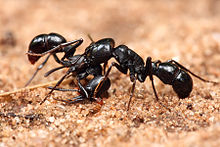Plectroctena
| Plectroctena | |
|---|---|

| |
| Two workers in Tanzania | |
| Scientific classification | |
| Domain: | Eukaryota |
| Kingdom: | Animalia |
| Phylum: | Arthropoda |
| Class: | Insecta |
| Order: | Hymenoptera |
| Family: | Formicidae |
| Subfamily: | Ponerinae |
| Tribe: | Ponerini |
| Genus: | Plectroctena F.Smith, 1858 |
| Type species | |
| Plectroctena mandibularis F.Smith, 1858
| |
| Diversity[1] | |
| 17 species | |
| Synonyms | |
|
Cacopone Santschi, 1914 | |

Plectroctena is an Afrotropical genus of ants, with most species occurring in the rainforest zones of West and Central Africa.[2] Some species are cryptic or subterranean foragers,[2] while others forage in open grassland terrain. The workers forage singly[3] or in groups of 2 to 3.[4] They nest in the earth at varying depths, or in collapsed logs. They prey mainly on millipedes, including their young or eggs.[2]
Colony structure
[edit]A colony of P. lygaria (a small species of the mandibularis-group) may number in excess of 300 adults. An excavated colony in the Ivory Coast consisted of 277 workers, 8 alate queens, and 42 alate males. Consequently 15% of their number was allocated to reproductives at the specific time.[2] The colony size of P. mandibularis however, seldom exceeds 50 individuals.[2][3]
Nests
[edit]In a colony of P. lygaria, the nest chambers are located at shallow depth, in moist soil under dense leaf litter. The deepest chamber may be located about 7 cm below the surface, with each chamber up to 1 cm in height.[2] The chambers are specialized to house either brood or prey items. Nests of the widespread species P. mandibularis however, are composed of chambers typically located 2 feet or more below the surface, with entrances that are usually marked by large piles of earth.[3][2]
Diet
[edit]It is believed that millipede eggs may at times constitute the exclusive diet of P. lygaria,[2] while newly emerged millipede young may be an additional food source for the smaller Plectroctena species. Larger species like P. conjugata, P. mandibularis and P. minor specialize on adult millipedes.[2]
Species
[edit]- Plectroctena anops Bolton, 1974
- Plectroctena conjugata Santschi, 1914
- Plectroctena cristata Emery, 1899
- Plectroctena cryptica Bolton, 1974
- Plectroctena dentata Santschi, 1912
- Plectroctena gabonensis Santschi, 1919
- Plectroctena gestroi Menozzi, 1922
- Plectroctena hastifera (Santschi, 1914)
- Plectroctena laevior Stitz, 1924
- Plectroctena latinodis Santschi, 1924
- Plectroctena lygaria Bolton, Gotwald & Leroux, 1979
- Plectroctena macgeei Bolton, 1974
- Plectroctena mandibularis F.Smith, 1858
- Plectroctena minor Emery, 1892
- Plectroctena strigosa Emery, 1899
- Plectroctena subterranea Arnold, 1915
- Plectroctena thaui Fisher, 2006
- Plectroctena ugandensis Menozzi, 1933
References
[edit]- ^ Bolton, B. (2014). "Plectroctena". AntCat. Retrieved 4 July 2014.
- ^ a b c d e f g h i Bolton, B.; Gotwald, W. H.; Leroux, J-M (1976). "A new West African ant of the genus Plectroctena with ecological notes (Hymenoptera: Formicidae)" (PDF). Annales de l'Université d'Abidjan, Série E (Écologie). Archived from the original (PDF) on 12 September 2011. Retrieved 5 September 2013.
- ^ a b c Arnold, G. (1915). "A monograph of the Formicidae in South Africa. Part I.". Annals of the South African Museum. 14: 1–159.
- ^ Bolton, B. (1974). "A revision of the Ponerine ant genus Plectroctena F. Smith (Hymenoptera: Formicidae)". Bulletin of the British Museum. 30: 309–338.
External links
[edit] Media related to Plectroctena at Wikimedia Commons
Media related to Plectroctena at Wikimedia Commons- Genus: Plectroctena, AntWeb
